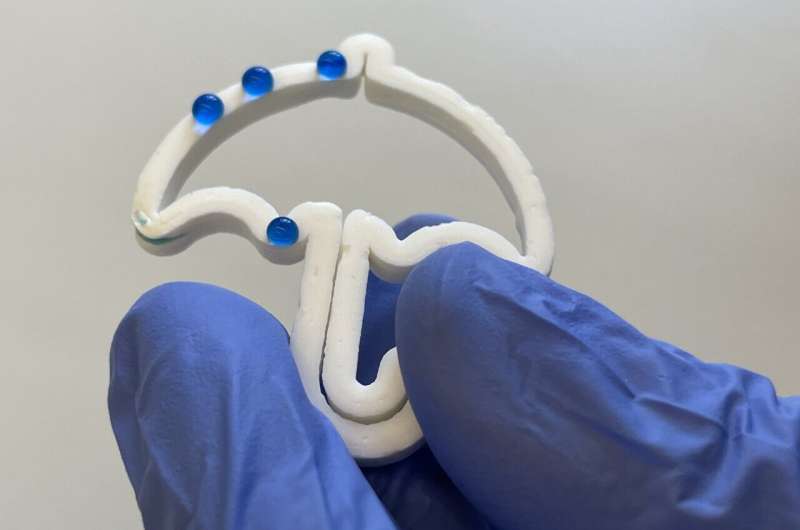
At first glance, biodegradable materials, inks for 3D printing and aerogels don’t seem to have much in common. All three have great potential for the future; however, “green” materials do not pollute the environment, 3D printing can produce complex structures without waste, and ultra-light aerogels are excellent heat insulators.
Empa researchers have now succeeded in combining all these advantages in a single material. And their cellulose-based, 3D-printable aerogel can do even more. The study is published in Advanced Science.
The material was created under the leadership of Deeptanshu Sivaraman, Wim Malfait and Shanyu Zhao from Empa’s Building Energy Materials and Components laboratory, in collaboration with the Cellulose & Wood Materials and Advanced Analytical Technologies laboratories as well as the Center for X-ray Analytics.
Together with other researchers, Zhao and Malfait had already developed a process for printing silica aerogels in 2020. This was no trivial task: Silica aerogels are foam-like materials, highly open porous and brittle. Before the Empa development, shaping them into complex forms had been pretty much impossible. “It was the logical next step to apply our printing technology to mechanically more robust bio-based aerogels,” says Zhao.
The researchers chose the most common biopolymer on Earth as their starting material: cellulose. Various nanoparticles can be obtained from this plant-based material using simple processing steps. Doctoral student Sivaraman used two types of such nanoparticles—cellulose nanocrystals and cellulose nanofibers—to produce the “ink” for printing the bio-aerogel.

More than 80% water
The flow characteristics of the ink are crucial in 3D printing: It must be viscous enough in order to hold a three-dimensional shape before solidification. At the same time, however, it should liquefy under pressure so that it can flow through the nozzle. With the combination of nanocrystals and nanofibers, Sivaraman succeeded in doing just that: The long nanofibers give the ink a high viscosity, while the rather short crystals ensure that it has shear thinning effect so that it flows more easily during extrusion.
In total, the ink contains around 12% cellulose—and 88% water. “We were able to achieve the required properties with cellulose alone, without any additives or fillers,” says Sivaraman. This is not only good news for the biodegradability of the final aerogel products, but also for its heat-insulating properties. To turn the ink into an aerogel after printing, the researchers replace the pore solvent water first with ethanol and then with air, all while maintaining shape fidelity. “The less solid matter the ink contains, the more porous the resulting aerogel,” explains Zhao.
This high porosity and the small size of the pores make all aerogels extremely effective heat insulators. However, the researchers have identified a unique property in the printed cellulose aerogel: It is anisotropic. This means its strength and thermal conductivity are direction-dependent.
“The anisotropy is partly due to the orientation of the nanocellulose fibers and partly due to the printing process itself,” says Malfait. This allows the researchers to control in which axis the printed aerogel piece should be particularly stable or particularly insulating. Such precisely crafted insulating components could be used in microelectronics, where heat should only be conducted in a certain direction.
Many potential applications in medicine
Although the original research project was primarily interested in thermal insulation, the researchers quickly saw another area of application for their printable bio-aerogel: medicine. As it consists of pure cellulose, the new aerogel is biocompatible with living tissues and cells.
Its porous structure is able to absorb drugs and then release them into the body over a long period of time. And 3D printing offers the possibility of producing precise shapes that could, for instance, serve as scaffolds for cell growth or as implants.
A particular advantage is that the printed aerogel can be rehydrated and re-dried several times after the initial drying process without losing its shape or porous structure. In practical applications, this would make the material easier to handle: It could be stored and transported in dry form and only be soaked in water shortly before use.
When dry, it is not only light and convenient to handle, but also less susceptible to bacteria—and does not have to be elaborately protected from drying out. “If you want to add active ingredients to the aerogel, this can be done in the final rehydration step immediately before use,” says Sivaraman. “Then you don’t run the risk of the medication losing its effectiveness over time or if it is stored incorrectly.”
The researchers are also working on drug delivery from aerogels in a follow-up project—with less focus on 3D printing for now. Shanyu Zhao is collaborating with researchers from Germany and Spain on aerogels made from other biopolymers, such as alginate and chitosan, derived from algae and chitin respectively.
Meanwhile, Wim Malfait wants to further improve the thermal insulation of cellulose aerogels. And Deeptanshu Sivaraman has completed his doctorate and has since joined the Empa spin-off Siloxene AG, which creates new hybrid molecules based on silicon.

